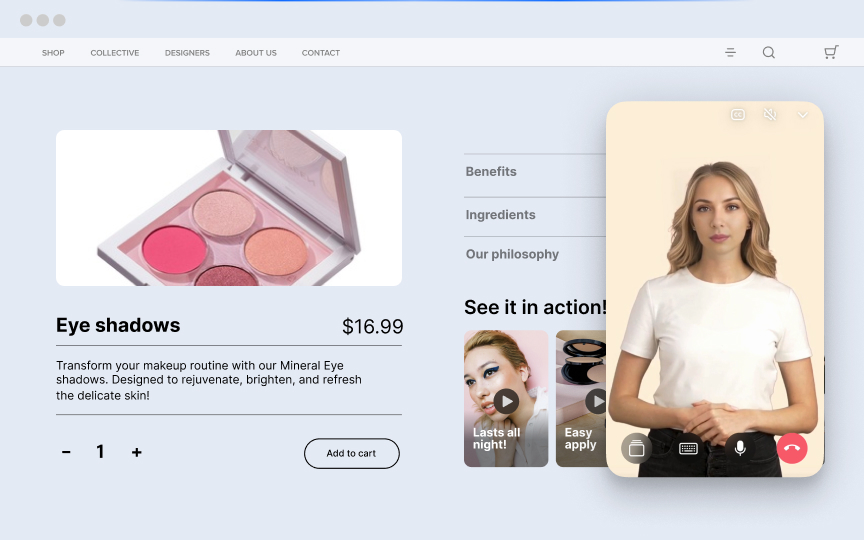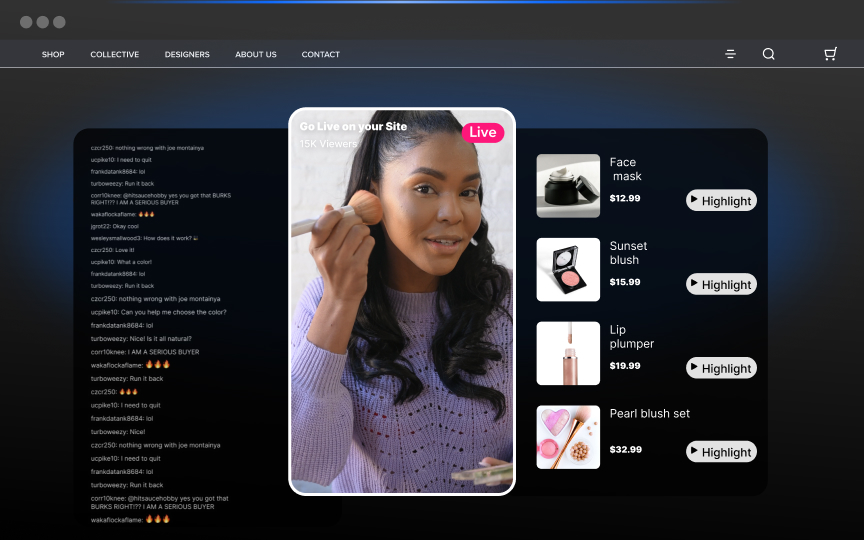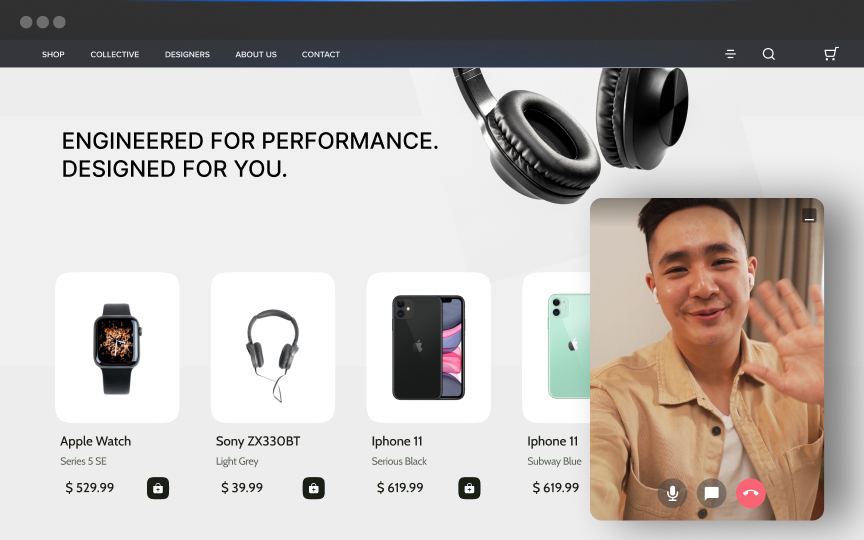By the end of 2022, China's top Live Commerce platforms will rake upwards of $600 billion worth of GMV. Livestream shopping started only in 2016, and it has gone on to power 20.3% of all E-Commerce sales in the region. Brands are discovering a powerful new way to enhance the digital shopping experience with conversion rates between 30%-40%, a 10x improvement compared to traditional e-commerce practices.

Livestream Shopping's share of online shopping in China - *Statista 2022
During the lead-up to China's 2021 Singles Day event, two 'Livestream influencers' put on a show for 12 hours, generating $3 billion worth of sales and around 488 million viewers. The traffic load was so intense that the TaoBao platform reported brief outages. When was the last time you experienced this kind of impact on your E-Commerce platform?
According to Mckinsey's analysis, Live Commerce-powered sales could generate up to 20% of all e-commerce sales by 2026. During Covid-19 alone, Live Commerce usage spiked massively by 76%, according to Statista reports.
Firework's Co-founder & CEO, Vincent Yang, recently participated in a webinar with Coresight Research's CEO, Deborah Weinswig, to debunk 6 top myths surrounding Live Commerce.

The conversation touches upon several key factors that demystify the meteoric rise of live stream shopping in China and how brands can craft an effective Live Commerce strategy for unrestricted growth. You can catch the entire webinar on Linkedin.In this post, we debunk the top 6 myths of Live Commerce and help you understand how your brand can maximize the impact of Livestream shopping for business growth in 2022.
Myth #1: Large marketplaces dominate the live streaming e-commerce space

Reality: Brands that have deployed an end-to-end Live Commerce on their website/app are experiencing significantly higher impact across the customer journey. When we talk about Livestreaming eCommerce in the West, existing players like Amazon Live are compared to Alibaba and Taobao Live, given the size of the E-Commerce pie they cover. In reality, significant marketplaces struggle to generate a large enough audience using Live Commerce. Taking Amazon Live's example, the brand has been trying to replicate Taobao's success since the last years, but their streams struggle to generate enough viewership or conversions. A typical stream consists of <1000 viewers: numbers that aren't good enough to impact business growth.
The reason is the construct of these marketplaces, which are created to simplify online shopping with search. Consumers on Amazon are in pro-active search mode and aren't looking to discover new products or brands via content-driven shopping. They know what they want to buy and look for the best possible deal. The Livestream content is hosted by prominent influencers who don't significantly impact consumer buying behavior. Of late, their content quality has also struggled, failing to create a better experience for the average marketplace shopper to switch over effectively.
There is a complete mindset shift when comparing Chinese consumers to the Western world, well-versed with live commerce platforms and know what to expect. In China, the experiential, community aspect of live commerce is a game-changer, bringing together large groups of people to be a part of an entire experience, not just shop for convenience. Their choice of Livestream hosts (KOL's, Micro-influencers) complements the content engagement with high-value addition as a prime feature, helping shoppers with real-world examples and facts to improve their buying decision process.
Myth #2: Creating Livestream content is like making TV commercials: difficult and expensive

Reality: Powerful Livestream content can be produced quickly from your storefront using a smartphone camera and a live commerce app
A popular misconception about Livestream content is that it's expensive to produce, requiring specialist equipment and costly celebrity hosts, made in a studio environment. This suggestion couldn't be further from the truth. Learning from China's successful model, good quality, high-engagement Livestream campaigns can be created using a simple smartphone app generic lighting from the comfort of your home.
China's top live commerce platforms have demonstrated massive success with brands campaigns using sales associates and micro-influencers who command more respect via their product knowledge and passion. Users get a lot of helpful information about the products and the brand. The resultant live streams have had exceptionally high engagement and conversions because of the direct impact on content quality.The most successful brands have leveraged their storefronts to re-create the physical shopping experience by creating simple Livestream campaigns in-store using salespeople to drive engagement, giving the benefit of a phygital shopping experience to customers and visitors.
Myth #3: Social media broadcasting will drive up sales

Reality: Brands are better off building a live commerce ecosystem on their website where customers intend to buy products.
Social media has a captive audience that tricks brands into believing that the traffic will generate conversions. Views don't always convert into sales, as the social media traffic is low shopping intent. According to most data points, add-to-cart rates across social media live-commerce setups vary between 0.1 - 0.2% only. Compared to that, 97 % of transactions still occur on brand websites where super-high intent traffic is present with a state of readiness to transact.
Most social media platforms are cluttered with UGC (user-generated content) varying across several themes meant for diverse audience groups. Brands are always competing for attention amidst a barrage of content, and the ability to create clutter-breaking content that maximizes recall, conversions, and ultimately, customer retention, is highly challenging.Social media might be well suited for impulse buys. Still, it certainly isn't the lead anchor for brands looking to build a powerful live commerce growth strategy powering significant CX improvements.
Myth #4: Livestreaming is used mainly for sales promotions

Reality: Live Commerce is supercharging brand awareness and customer retention and powering a shift from traditional e-commerce to omnichannel digital transformation
The shift to a three-dimensional, mobile-optimized video shopping experience is helping new-age customers connect with brands using their preferred mode of engagement, live, short-form video. Brands are leveraging the power of live streaming for brand awareness and building strong communities around their brands. Livestream campaigns allow customers to come together on an immersive, interactive video-powered shopping experience and interact not just with the brand but other individuals on the open web.
The 'shoppertainment' element of live commerce keeps customers coming back for more and brings in more customers via word-of-mouth to add to the community element, driving up customer retention and traffic.For example, grocery giant Albertsons has created a powerful video-first shopping experience on their platform to allow customers to not just shop but seek inspiration from their content. The goal for Albertsons was to develop the 'Pinterest for food' experience on their website, enabling customers to learn more about food through educational, interactive video content. The brand fosters a community of enthusiasts who keep coming back on the website to learn, get inspired and shop.Also, the experiential element of live commerce delivers massive value to consumers via exceptional product knowledge delivery, helping customers significantly in their purchase decisions.Example: A clothing retailer can successfully demonstrate the fit and styling of clothes using interactive video to help consumers understand what works well, effectively reducing product returns.
Myth #5: Bringing celebrities to live streams are going to bring more sales
Reality: Creating authentic, organic connections with the audience using knowledgeable salespeople is more effective in driving up sales via live commerceIn today's creator economy, influencers have disrupted the field of celebrity-led brand promotions via social media. However, the new-age consumers (GenZ and Millennials) despise anything that carries a 'sponsored' tag, and prominent influencers can rarely create a lasting impact for brands anymore when it comes to sales.Brands have overdone influencer marketing, so much so that there is rarely a connection between the brand and the influencer sponsoring the brand's product. The result is poor quality live stream campaigns with low engagement that don't inspire consumers to transact.
Brands in China have cracked the code to host successful Livestream shopping events by using salespeople and micro-influencers. Your sales associates will have the most up-to-date and accurate information about your product portfolio. They can create high-engagement, high-value customer interactions that push consumers further down the sales funnel.
A successful Livestream campaign requires an organic connection between the host and the audience with real-world information that adds more value to the buying journey and simplifies the purchase decision.
Myth #6: Sales conversion tracking is the only metric that matters

Reality: Live Commerce is a full-funnel solution that requires brands to account for the entire customer journey, right from first impression to conversion to repeat purchase
The cart-to-checkout rate for an average e-commerce website is around 2%, with a typical 7-day buyer journey that transpires. Looking at only the sales conversion rate would be a very myopic approach focused on short-term gains. The correct way to structure your live commerce strategy would be to observe growth throughout the customer journey.
Here are three additional metrics that brands need to track:
- Engagement times (session length): With live streams, brands experience up to 2X to 4X bump in session length almost immediately
- Engagement rate: To match the average conversion cycle, brands need to account for all the touchpoints across the buying journey (clicks, chat interactions, reactions, video views, add to cart rate, etc.)
- Returning users: Keeping track of users coming back to your website to watch a new stream, shoppable video, the old recorded content, etc., is crucial to deliver a more personalized shopping experience, tailor-made based on previous interactions.
Summary
Live Commerce is revolutionizing traditional E-Commerce and helping customers discover a powerful new way to shop online that combines the best of physical shopping with the convenience of online shopping. With live-stream shopping, brands are :1. Driving Up Sustainability - Up to 50% reduction in returns for brands2. Improving KYC Process Effectiveness - Refining the 'know your customer' operation by gathering critical customer data points3. Empowering Sales Teams - Professionalisation of sales associates and leveraging store real estate to maximize conversionsAt Firework, brands create high-performance live commerce experiences with the best-in-class platform and services. Please schedule a consultation with our solution architects to understand how your brand can benefit from Live Commerce.
Unlock Exclusive Insights
By submitting this form, you agree to Firework's privacy policy and consent to receive personalized marketing communications. You can unsubscribe at any time.






























